The process of turning cleansed cotton fibers into yarn or thread is called spinning. Following ginning, spinning machines are used to stretch, twist, and straighten the fibers into long, continuous strands. Fabrics are then knitted or woven using this yarn. Because it affects the final fabric’s strength, smoothness, and quality, spinning is an essential stage in the textile manufacturing process.


